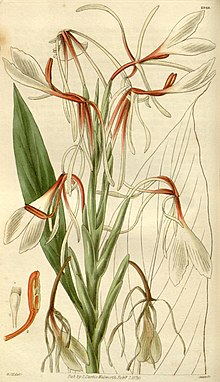| This article includes a list of general references, but it lacks sufficient corresponding inline citations. Please help to improve this article by introducing more precise citations. (October 2024) (Learn how and when to remove this message) |
| Spiked ginger lily | |
|---|---|

| |
| Conservation status | |
 Least Concern (IUCN 3.1) | |
| Scientific classification | |
| Kingdom: | Plantae |
| Clade: | Tracheophytes |
| Clade: | Angiosperms |
| Clade: | Monocots |
| Clade: | Commelinids |
| Order: | Zingiberales |
| Family: | Zingiberaceae |
| Genus: | Hedychium |
| Species: | H. spicatum |
| Binomial name | |
| Hedychium spicatum Sm. | |
| Synonyms | |
| |
Hedychium spicatum is a plant species native to China (Guizhou, Sichuan, Tibet, Yunnan), the Himalayas, Myanmar, and Thailand.
Hedychium spicatum is a small, hardy perennial that grows to around 1 m (3 ft 3 in), with green leaves and large orange and white flowers. It is also commonly known as spiked ginger lily, or perfume ginger.
Uses
| This section does not cite any sources. Please help improve this section by adding citations to reliable sources. Unsourced material may be challenged and removed. (March 2020) (Learn how and when to remove this message) |
The Indian medicinal system (Ayurveda) described the species as having pungent, light, bitter, strong, heating properties. The species is also an ingredient of some traditional Chinese medicine (TCM), traditional Tibetan medicine and Unani medicine. The powder and decoction of the rhizome are used for a variety of conditions. The rhizome is also chewed by the inhabitants of Uttarakhand to clean their mouths and freshen their breath.
The fruit of this species may be cooked and eaten with lentils in savoury dishes. Crushed rhizomes, both fresh and dried, are very aromatic with a fragrant, somewhat pungent smell similar to orris root but more powerful. In Manipur, the rhizome is cooked to prepare chutney.
"Abir", a fragrant coloured powder marketed for religious ceremonies, is prepared from its dried rhizomes. In Himachal Pradesh, leaves are used in making mats for the home, combined with wheat straw, enhancing the durability of the product. The aromatic dried root of this plant is often used as an incense in Ethiopia. The essential oil has a fragrance somewhat like hyacinths with a long-lasting scent.
References
- Chauhan, H.K. (2024). "Hedychium spicatum". IUCN Red List of Threatened Species. 2024: e.T46960086A46960123. Retrieved 20 October 2024.
- "Hedychium spicatum Sm". Plants of the World Online. Royal Botanic Gardens, Kew. Retrieved 21 October 2024.
- Flora of China v 24 p 373, 草果药 cao guo yao, Hedychium spicatum Smith in Rees, Cycl. 17: Hedychium no. 3. 1811.
External links
| Taxon identifiers | |
|---|---|
| Hedychium spicatum |
|
This Zingiberales-related article is a stub. You can help Misplaced Pages by expanding it. |